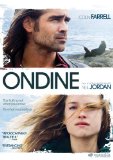Written by Diane Tillis
If I had to pick two words to describe Ondine, I would pick hauntingly beautiful. Neil Jordon, the popular Irish director and writer, comes up with an unusual modern fairy tale. Ondine is a film about people from different worlds hoping that dreams really can come true. It is a film about redemption and hope, harsh reality versus fantasy. Ondine is a journey of self discovery to be experienced from the darkness back into the light. It reminds us that enchantment and darkness are a part of every story.
Syracuse (Colin Farrell) is an Irish fisherman whose life is transformed when he catches a mysterious woman (Alicja Bachleda) in his nets. She says her name is Ondine, which means “she came from the sea.” Syracuse helps Ondine by letting her hide at his mother’s abandoned home. Occasionally Ondine goes fishing with Syracuse and sings a siren’s song to lure fish into his net.
As Syracuse gets to know Ondine, he tells his daughter Annie (Alison Barry) a story based upon Ondine’s mysterious nature. Annie connects the details of Syracuse’s story to the Celtic myth of a selkie, a magical seal/woman creature. In the myth, a selkie is able to become human by taking off her seal coat, and can return to seal form by putting it back on. Annie begins to believe that her father’s story is not just another made-up story and discovers Ondine’s hiding spot. Annie hopes that Ondine has come to be a part of their family and that she can use her powers to cure Annie’s kidney failure. Syracuse’s and Ondine’s relationship grows from curiosity to love. Annie looks to Ondine as a pillar of hope in a world that sees very little.
The darker side of the story begins to reveal itself when another mysterious figure comes to town. Who is the menacing man lurking around town? Is he related to Ondine’s true secret? To discuss more on the darker aspects of this story would be to ruin the magical appeal of the film.
Video
The film is presented in it’s original aspect ratio of 1.85:1. By using Ireland as the backdrop of the film, Neil Jordon enhances the themes of enchantment and mysticism through the landscape. One great thing about Jordon’s directing is he prefers to use natural lighting and very little computer enhancement. Jordon’s use of natural lighting makes the film seem to be darker than normal. The final boat sequence towards the end could use some form of lighting. Since the scene takes place at night and on the water, available natural light is limited. Not that it is impossible to understand what is going on in the scene; it is just a little difficult. While it is not bright with clear colors or high contrasts, the visual part of the film is unique
Audio
The audio is presented in Dolby Digital 5.1. Sometimes the background sounds (such as crashing waves) can overwhelm a scene, but this only happened once or twice. A line of the dialog may be difficult for some viewers to make out. This is due to an actor either mumbling with an Irish accent or speaking to quickly to catch.
Special Features
There are two behind-the-scenes featurettes on the DVD. Making Ondine and HDNet: a Look at Ondine both use cast interviews and directorial interviews to give a more in-depth look into the psyche of the story.
Final Thoughts
Very rarely do I feel emotionally moved by a film. I was hoping for these characters, dreaming with them, and invested in their journey. Ondine is a raw film, not afraid to show the true emotions of human complexity. I applaud Neil Jordon for creating a beautiful film that made me want to believe again. Not just in the magic of life, but to believe that through the darkness there can still be hope.





